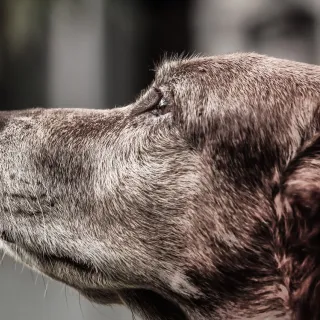Helping Your Aging Dog Adjust to a New Member of the Family by Devin Morrissey
This article has been republished for exclusive use by The Grey Muzzle Organization with the permission of original author, Devin Morrissey.
Typically, couples will experiment with parenting by getting a puppy, and by the time the dog is older and trained, they decide to become parents to a child of their own. For most couples, their dog is like their first child — until they really have their firstborn.
The couple will quickly learn how different the two situations are from one another. You can’t simply put your baby in a crate when you want to leave the house, and you suddenly no longer can allow your dog to jump up on anything: the couch, the bed, people, or especially the baby. Learning how to teach both the baby and the older dog to coexist is essential to creating harmony in the home.
Matchmaking Between Baby and Dog
Acclimate your older animal by starting to use some of the baby lotions, soaps and shampoos on yourself long before the baby’s arrival. Dogs’ noses tell them much of what they understand about the world. It will start to connect that the baby belongs with you in your home and that they are part of the family.
When you bring your baby home, do not put your newborn directly in front of your animal’s face. There is no telling how your animal may react. To take things slow when your dog first meets your baby, consider doing it on the other side of a baby gate. It will allow them to smell the baby while you watch how the two interact. If the animal responds by growling or snapping at the child, it is best to keep your distance until you can work out another plan of introduction.
Get Your Friends In On It
To get your dog mentally prepared to have a new small person in their home, socialize your pet with other small humans. If you have friends or co-workers with small children, set up a meetup date. Getting your dog comfortable with smaller children will help to set them up for success for when you bring the baby home. Make sure to keep a watchful eye on them when they are together. Something as innocent as a child pulling too roughly on a dog’s ear can be enough to cause a negative reaction from the dog.
Similarly, if you have a friend with an older dog that you know is good with children, invite them over to your house. As an act of precaution, make sure that your guest’s dog is up-to-date on their vaccinations before they meet your newborn. If your old dog is having trouble adjusting to the new little one in your house, it may help for them to see another dog interacting with them in a positive way. Dogs are pack animals after all, and they often follow the lead of other dogs in uncomfortable situations.
Give Everyone Some Space
If you are sensing that your dog may be feeling suffocated with the presence of another person in the house, perhaps it is time to expand your family home. Dogs are likely to be more tolerable of small children when the animal is tired. Giving your animal a backyard and the ability to run and play may be just what the doctor ordered to allow the two to get along. If you decide to move into a bigger house because of your new child, you'll want to consider these tips on moving your dog into a new environment. It might take some time for your older pet to adjust.
In your new home, consider making a designated area just for your animal. It will reduce the amount of dog odors in your home and protect the carpets that your child will eventually crawl on from being filled with fur and dirt. Older dogs can appreciate a designated resting spot with a plush dog bed. Once your baby and your pet have made a deep connection you can expect to find them both napping in their on occasion.
Make sure to not ever leave your baby and your pet alone without supervision. Even if they seem to be getting along like old friends, there is still potential for them to have a moment of discomfort. Taking a few precautions in the beginning may just have your first furry friend and your firstborn getting along in no time.
About the Contributor:
Devin roams the Pacific Northwest, bringing his dog, Scrummy, whenever possible. He is a strong believer that nothing can compare to a dog's unconditional love.
You can follow him and Scrummy on Twitter.



